Search
- Page Path
- HOME > Search
- [English]
- Fabrication of Sintered Compact of Fe-TiB2 Composites by Pressureless Sintering of (FeB+TiH2) Powder Mixture
- Xuan-Khoa Huynh, Ji Soon Kim
- J Korean Powder Metall Inst. 2016;23(4):282-286. Published online August 1, 2016
- DOI: https://doi.org/10.4150/KPMI.2016.23.4.282
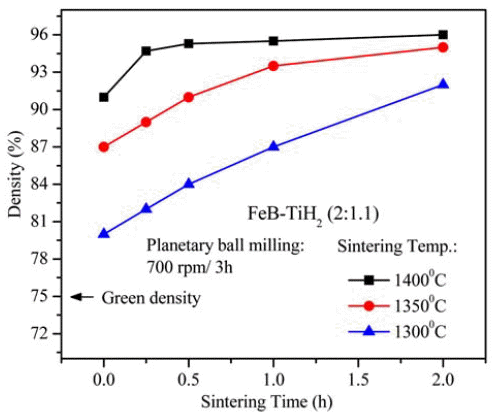
- 797 View
- 1 Download
- 3 Citations
-
 Abstract
Abstract
 PDF
PDF A sintered body of TiB2-reinforced iron matrix composite (Fe-TiB2) is fabricated by pressureless-sintering of a mixture of titanium hydride (TiH2) and iron boride (FeB) powders. The powder mixture is prepared in a planetary ball-mill at 700 rpm for 3 h and then pressurelessly sintered at 1300, 1350 and 1400°C for 0-2 h. The optimal sintering temperature for high densities (above 95% relative density) is between 1350 and 1400°C, where the holding time can be varied from 0.25 to 2 h. A maximum relative density of 96.0% is obtained from the (FeB+TiH2) powder compacts sintered at 1400°C for 2 h. Sintered compacts have two main phases of Fe and TiB2 along with traces of TiB, which seems to be formed through the reaction of TiB2 formed at lower temperatures during the heating stage with the excess Ti that is intentionally added to complete the reaction for TiB2 formation. Nearly fully densified sintered compacts show a homogeneous microstructure composed of fine TiB2 particulates with submicron sizes and an Fe-matrix. A maximum hardness of 71.2 HRC is obtained from the specimen sintered at 1400°C for 0.5 h, which is nearly equivalent to the HRC of conventional WC-Co hardmetals containing 20 wt% Co.
-
Citations
Citations to this article as recorded by- Optimizing the Microstructure and Properties of Fe–Ni–Cu–Mo–C Sintered Steel by TiB2
Zenglin Liu, Yankang Wang, Weilong Lu, Feng Liu, Wei Han, Wuqiang He
Science of Advanced Materials.2024; 16(6): 707. CrossRef - Effect of Ce Addition on the As-Cast and As-Forged Microstructure of Fe-TiB2 Composites
Lin Zhang, Jianwen Gao, Minghao Huang, Engang Wang
JOM.2019; 71(11): 4144. CrossRef - Microstructure, mechanical, and tribological properties of pressureless sintered and spark plasma sintered Fe TiB2 nanocomposites
Hak-Rae Cho, Ji-Soon Kim, Koo-Hyun Chung
Tribology International.2019; 131: 83. CrossRef
- Optimizing the Microstructure and Properties of Fe–Ni–Cu–Mo–C Sintered Steel by TiB2
- [Korean]
- Sintering of Fe-30 wt% TiC Composite Powders Fabricated from (Fe, TiH2, C) Powder Mixture
- Byunghoon Lee, Ji Soon Kim
- J Korean Powder Metall Inst. 2015;22(5):356-361. Published online October 1, 2015
- DOI: https://doi.org/10.4150/KPMI.2015.22.5.356
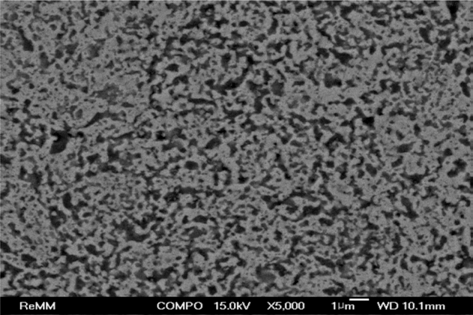
- 774 View
- 1 Download
- 3 Citations
-
 Abstract
Abstract
 PDF
PDF Fe-30 wt% TiC composite powders are fabricated by in situ reaction synthesis after planetary ball milling of (Fe, TiH2, Carbon) powder mixture. Two sintering methods of a pressureless sintering and a spark-plasma sintering are tested to densify the Fe-30 wt% TiC composite powder compacts. Pressureless sintering is performed at 1100, 1200 and 1300°C for 1-3 hours in a tube furnace under flowing argon gas atmosphere. Spark-plasma sintering is carried out under the following condition: sintering temperature of 1050°C, soaking time of 10 min, sintering pressure of 50 MPa, heating rate of 50°C/min, and in a vacuum of 0.1 Pa. The curves of shrinkage and its derivative (shrinkage rate) are obtained from the data stored automatically during sintering process. The densification behaviors are investigated from the observation of fracture surface and cross-section of the sintered compacts. The pressureless-sintered powder compacts are not densified even after sintering at 1300°C for 3 h, which shows a relative denstiy of 66.9%. Spark-plasma sintering at 1050°C for 10 min exhibits nearly full densification of 99.6% relative density under the sintering pressure of 50 MPa.
-
Citations
Citations to this article as recorded by- Abrasive Wear Performance of Spherical Hierarchical Structured TiC/High-Manganese Steel Composites
Tao He, Shengnian Zhao, Dehong Lu, Yehua Jiang, Mojin Zhou
Materials.2024; 18(1): 130. CrossRef - Effect of TiC particle size on high temperature oxidation behavior of TiC reinforced stainless steel
Yeong-Hwan Lee, Sungmin Ko, Hyeonjae Park, Donghyun Lee, Sangmin Shin, Ilguk Jo, Sang-Bok Lee, Sang-Kwan Lee, Yangdo Kim, Seungchan Cho
Applied Surface Science.2019; 480: 951. CrossRef - Effect of TiC addition on surface oxidation behavior of SKD11 tool steel composites
Seungchan Cho, Ilguk Jo, Heebong Kim, Hyuk-Tae Kwon, Sang-Kwan Lee, Sang-Bok Lee
Applied Surface Science.2017; 415: 155. CrossRef
- Abrasive Wear Performance of Spherical Hierarchical Structured TiC/High-Manganese Steel Composites
- [Korean]
- Effect of Oxygen Content in the Tungsten Powder Fabricated by Electrical Explosion of Wire Method on the Behavior of Spark-Plasma Sintering
- Cheol-Hee Kim, Seong Lee, Byung-Kee Kim, Ji Soon Kim
- J Korean Powder Metall Inst. 2014;21(6):447-453. Published online December 1, 2014
- DOI: https://doi.org/10.4150/KPMI.2014.21.6.447
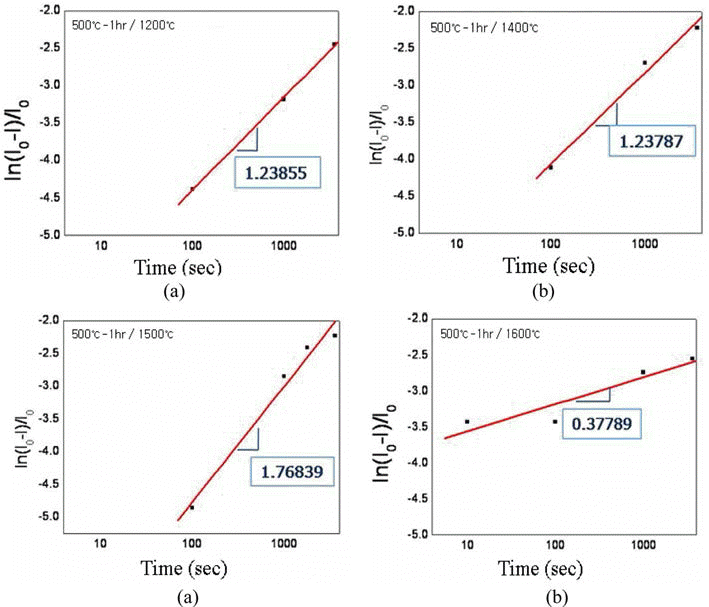
- 545 View
- 1 Download
- 1 Citations
-
 Abstract
Abstract
 PDF
PDF Effect of oxygen content in the ultrafine tungsten powder fabricated by electrical explosion of wire method on the behvior of spark plasma sintering was investigated. The initial oxygen content of 6.5 wt% of as-fabricated tungsten powder was reduced to 2.3 and 0.7 wt% for the powders which were reduction-treated at 400°C for 2 hour and at 500°C for 1h in hydrogen atmosphere, respectively. The reduction-treated tungsten powders were spark-plasma sintered at 1200-1600°C for 100-3600 sec. with applied pressure of 50 MPa under vacuum of 0.133 Pa. Maximun sindered density of 97% relative density was obtained under the condition of 1600°C for 1h from the tungsten powder with 0.7 wt% oxygen. Sintering activation energy of 95.85 kJ/mol−1 was obtained, which is remarkably smaller than the reported ones of 380~460 kJ/mol−1 for pressureless sintering of micron-scale tungsten powders.
-
Citations
Citations to this article as recorded by- Effect of Powder Mixing Process on the Characteristics of Hybrid Structure Tungsten Powders with Nano-Micro Size
Na-Yeon Kwon, Young-Keun Jeong, Sung-Tag Oh
Journal of Korean Powder Metallurgy Institute.2017; 24(5): 384. CrossRef
- Effect of Powder Mixing Process on the Characteristics of Hybrid Structure Tungsten Powders with Nano-Micro Size
- [Korean]
- Spark Plasma Sintering of Fe-TiC Composite Powders
- Yong-Heui Lee, Xuan-Khoa Hyunh, Ji Soon Kim
- J Korean Powder Metall Inst. 2014;21(5):382-388. Published online October 1, 2014
- DOI: https://doi.org/10.4150/KPMI.2014.21.5.382
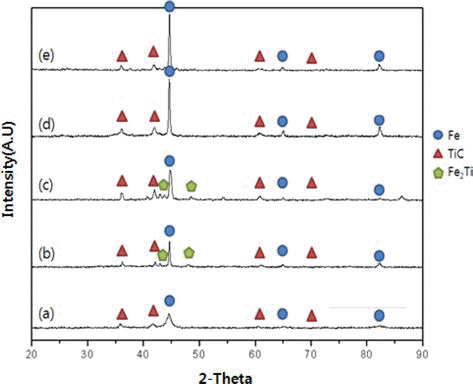
- 791 View
- 3 Download
- 3 Citations
-
 Abstract
Abstract
 PDF
PDF Fe-TiC composite powder was fabricated by high-energy milling of powder mixture of (Fe, TiC) and (FeO, TiH2, C) as starting materials, respectively. The latter one was heat-treated for reaction synthesis of TiC phase after milling. Both powders were spark-plasma sintered at various temperatures of 680-1070°C for 10 min. with sintering pressure of 70 MPa and the heating rate of 50°C/min. under vacuum of 0.133 Pa. Density and hardness of the sintered compact was investigated. Fe-TiC composite fabricated from (FeO, TiH2, C) as starting materials showed better sintered properties. It seems to be resulted from ultra-fine TiC particle size and its uniform distribution in Fe-matrix compared to the simply mixed (Fe, TiC) powder.
-
Citations
Citations to this article as recorded by- Comparative study of Ni-TaC composites via high-energy ball milling activation and spark plasma sintering: Reinforcement, densification, oxidation resistance, and mechanical property
Bum-Soon Park, Jeong-Han Lee, Jae-Cheol Park, Hyun-Kuk Park
Journal of Alloys and Compounds.2024; 984: 173900. CrossRef - Effect of TiC particle size on high temperature oxidation behavior of TiC reinforced stainless steel
Yeong-Hwan Lee, Sungmin Ko, Hyeonjae Park, Donghyun Lee, Sangmin Shin, Ilguk Jo, Sang-Bok Lee, Sang-Kwan Lee, Yangdo Kim, Seungchan Cho
Applied Surface Science.2019; 480: 951. CrossRef - Effect of TiC addition on surface oxidation behavior of SKD11 tool steel composites
Seungchan Cho, Ilguk Jo, Heebong Kim, Hyuk-Tae Kwon, Sang-Kwan Lee, Sang-Bok Lee
Applied Surface Science.2017; 415: 155. CrossRef
- Comparative study of Ni-TaC composites via high-energy ball milling activation and spark plasma sintering: Reinforcement, densification, oxidation resistance, and mechanical property
- [Korean]
- Effect of Solidification Condition of Sublimable Vehicles on the Pore Characteristics in Freeze Drying Process
- Myung-Jin Suk, Ji Soon Kim, Sung-Tag Oh
- J Korean Powder Metall Inst. 2014;21(5):366-370. Published online October 1, 2014
- DOI: https://doi.org/10.4150/KPMI.2014.21.5.366
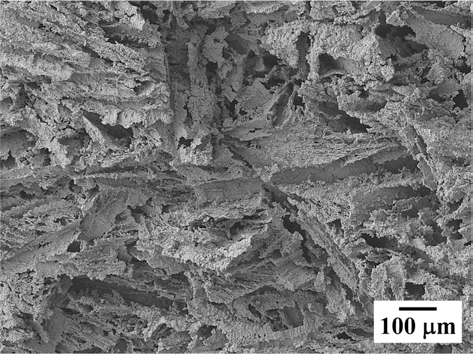
- 644 View
- 1 Download
- 2 Citations
-
 Abstract
Abstract
 PDF
PDF The present study demonstrates the effect of solidification condition on the pore structure in freeze drying process using the slurries of CuO/sublimable vehicles. Camphene and Camphor-45 wt% naphthalene based slurries with 14 vol% CuO powder were frozen into a mold at -25°C, followed by sublimation at room temperature. The green bodies were hydrogen-reduced and sintered at 500°C for 1 h. The porous Cu specimen, frozen the CuO/camphene slurry into the heated mold of the upper part, showed large pores with unidirectional pore channels and small pores in their internal wall. Also, it was observed that the size of large pores was decreasing near the bottom part of specimen. The change of pore structure depending on the freezing condition was explained by the nucleation behavior of camphene crystals and rearrangement of solid powders during solidification. In case of porous Cu prepared from CuO/Camphornaphthalene system, the pore structure exhibited plate shape as a replica of the original structure of crystallized vehicles with hypereutectic composition.
-
Citations
Citations to this article as recorded by- Interaction of Solid Particles with the Solidifying Front in the Liquid-Particle Mixture
Ho-Suk Lee, Kyu-Hee Lee, Sung-Tag Oh, Young Do Kim, Myung-Jin Suk
Journal of Korean Powder Metallurgy Institute.2018; 25(4): 336. CrossRef - Fabrication of Ti Porous body with Improved Specific Surface Area by Synthesis of CNTs
Hye Rim Choi, Jong Min Byun, Myung-Jin Suk, Sung-Tag Oh, Young Do Kim
Journal of Korean Powder Metallurgy Institute.2016; 23(3): 235. CrossRef
- Interaction of Solid Particles with the Solidifying Front in the Liquid-Particle Mixture
- [Korean]
- Planetary Ball Mill Process in Aspect of Milling Energy
- Huynh Xuan Khoa, Sunwoo Bae, Sangwon Bae, Byeong-woo Kim, Ji Soon Kim
- J Korean Powder Metall Inst. 2014;21(2):155-164. Published online April 1, 2014
- DOI: https://doi.org/10.4150/KPMI.2014.21.2.155
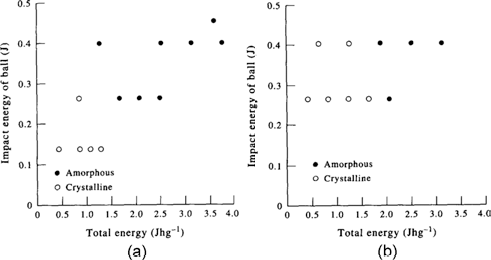
- 6,837 View
- 386 Download
- 39 Citations
-
 PDF
PDF -
Citations
Citations to this article as recorded by- Particle interactions during dry powder mixing and their effect on solvent-free manufactured electrode properties
Zhongjia Gao, Jinzhao Fu, Chinmoy Podder, Xiangtao Gong, Yan Wang, Heng Pan
Journal of Energy Storage.2024; 83: 110605. CrossRef - Towards a More Sustainable Leaching Process for Li-Ion Battery Cathode Material Recycling: Mechanochemical Leaching of LiCoO2 Using Citric Acid
Joshua Vauloup, Cécile Bouilhac, Nicolas Coppey, Patrick Lacroix-Desmazes, Lorenzo Stievano, Laure Monconduit, Moulay Tahar Sougrati
ACS Sustainable Resource Management.2024; 1(9): 2032. CrossRef - Conduction mechanism of a moisture diffusion energy harvesting device prepared with mesopore-rich activated carbon
Sa-Myeong Gim, Sadaf Mearaj, Hyeonoh Hwang, Xuanjun Jin, Joon Weon Choi
Materials Today Communications.2024; 40: 109743. CrossRef - Toksik organik kirleticilerin mekanokimyasal parçalanması
Volkan Pelitli
Balıkesir Üniversitesi Fen Bilimleri Enstitüsü Dergisi.2024; 26(2): 635. CrossRef - Navigating Ball Mill Specifications for Theory‐to‐Practice Reproducibility in Mechanochemistry
Orein F. Jafter, Sol Lee, Jongseong Park, Clément Cabanetos, Dominik Lungerich
Angewandte Chemie International Edition.2024;[Epub] CrossRef - Advancing sustainable practices in Li-ion battery cathode material recycling: mechanochemical optimisation for magnetic cobalt recovery
Joshua Vauloup, Cécile Bouilhac, Nicolas Coppey, Patrick Lacroix-Desmazes, Bernard Fraisse, Lorenzo Stievano, Laure Monconduit, Moulay Tahar Sougrati
RSC Mechanochemistry.2024; 1(4): 393. CrossRef - Ultrafine Sm2Fe17N3 hard magnetic particles synthesized by mechanochemical process
Zhi Yang, Yuanyuan Chen, Haochuan Yang, Xiaofeng Nie, Junhua Xi, Jie Zhang, Weiqiang Liu, Ming Yue
Applied Materials Today.2024; 41: 102453. CrossRef - Navigating Ball Mill Specifications for Theory‐to‐Practice Reproducibility in Mechanochemistry
Orein F. Jafter, Sol Lee, Jongseong Park, Clément Cabanetos, Dominik Lungerich
Angewandte Chemie.2024;[Epub] CrossRef - Optimizing reuse of Vanadis® 8 tool steel powders through multi-objective Lichtenberg algorithm: A powder metallurgy approach
Elioenai Levi Barbedo, João Luiz Junho Pereira, Lucas Antônio de Oliveira, Matheus David Guimarães Barbedo, Matheus Brendon Francisco, Guilherme Ferreira Gomes, Gilbert Silva
Advanced Powder Technology.2024; 35(4): 104416. CrossRef - Solution-Free Growth of CsPbBr3 Perovskite Films Using a Fast and Scalable Close Space Sublimation Method
Jakob Ihrenberger, Frédéric Roux, Ferdinand Lédée, Fabrice Emieux, Christelle Anglade, Thibault Lemercier, Géraldine Lorin, Eric Gros-Daillon, Louis Grenet
Crystal Growth & Design.2024; 24(13): 5542. CrossRef - Powder ball milling: An energy balance approach to particle size reduction
Stefano Martelli, Paolo Emilio Di Nunzio
Journal of Materials Research.2024;[Epub] CrossRef - Recent advances in the application of dolomite in membrane separation and beyond: A review on an abundant and versatile mineral
Muhammed Sahal Siddique, N Awanis Hashim, Mohd Usman Mohd Junaidi, Aubaid Ullah, Rozita Yusoff, Mohamad Fairus Rabuni
Materials Today Sustainability.2024; 28: 100951. CrossRef - Wet mechanochemical surface modification of calcite employing an integration of conventional design and analytical hierarchy process
Metin Uçurum, Akın Özdemir
Powder Technology.2024; 443: 119970. CrossRef - Bi-functional hydrogen tungsten bronze/carbon composite catalysts towards biomass conversion and solar water purification
Akitaka Yabuki, Kunihiko Kato, Yunzi Xin, Yuping Xu, Takashi Shirai
Materialia.2024; 38: 102249. CrossRef - Controlling Particle Size of Recycled Copper Oxide Powder for Copper Thermite Welding Characteristics
Hansung Lee, Minsu Kim, Byungmin Ahn
journal of Korean Powder Metallurgy Institute.2023; 30(4): 332. CrossRef - Influence of Mixing Process on the Performance of Electrodes Made by a Dry Coating Method
Ming Wang, Kubra Uzun, Bradley R. Frieberg, Jiazhi Hu, Anita Li, Xiaosong Huang, Yang-Tse Cheng
Journal of The Electrochemical Society.2023; 170(1): 010541. CrossRef - Influence of ball materials on the surface activation behavior of coal ash particles during a mechanochemical process
Takumi Sangu, Yunzi Xin, Takashi Hitomi, Kunihiko Kato, Takashi Shirai
Ceramics International.2023; 49(21): 34327. CrossRef - Mechanosynthesizing a dual cation orthophosphate using planetary ball mill; Potassium struvite production employing different primary components
Alimohammad Dehghan Manshady, Gholamreza Rakhshandehroo, Nasser Talebbeydokhti
Advanced Powder Technology.2022; 33(10): 103751. CrossRef - Comparison study of physicochemical and biopharmaceutics properties of hydrophobic drugs ground by two dry milling processes
M. Dandignac, S. P. Lacerda, A. Chamayou, L. Galet
Pharmaceutical Development and Technology.2022; 27(7): 816. CrossRef - Effects of two-step high-energy ball milling process and hot isostatic pressing on the mechanical properties of PM magnesium
Jesus María Rios, Alex Humberto Restrepo, Alejandro Alberto Zuleta, Francisco Javier Bolívar, Juan Guillermo Castaño, Esteban Correa, Félix Echeverria
The International Journal of Advanced Manufacturing Technology.2022; 121(1-2): 187. CrossRef - A chemical milling process to produce water-based inkjet printing ink from waste tire carbon blacks
I-Feng Wu, Ying-Chih Liao
Waste Management.2021; 122: 64. CrossRef - Microstructural Design of Ba0.5La0.5Co0.5Fe0.5O3 Perovskite Ceramics
Daria Gierszewska, Iga Szpunar, Francis Oseko, Joanna Pośpiech, Małgorzata Nadolska, Martyna Pieragowska, Karolina Reniecka, Kinga Waniek, Karol Leszczyński, Aleksandra Mielewczyk-Gryń, Maria Gazda, Sebastian Wachowski
Materials.2021; 14(16): 4656. CrossRef - Mechanical high-energy treatment of TiNi powder and phase changes after electrochemical hydrogenation
E.V. Abdulmenova, S.N. Kulkov
International Journal of Hydrogen Energy.2021; 46(1): 823. CrossRef - Rejuvenation of granulated blast furnace slag (GBS) glass by ball milling
N. Romero Sarcos, D. Hart, H. Bornhöft, A. Ehrenberg, J. Deubener
Journal of Non-Crystalline Solids.2021; 556: 120557. CrossRef - Key Factors During the Milling Stage of the Seed‐assisted and Solvent‐free Synthesis of MFI and Catalytic Behavior in the Alkylation of Phenol with Tert‐butyl Alcohol
Julieth Tatiana García‐Sánchez, Iván Darío Mora‐Vergara, Daniel Ricardo Molina‐Velasco, José Antonio Henao‐Martínez, Víctor Gabriel Baldovino‐Medrano
ChemCatChem.2021; 13(16): 3713. CrossRef - Nanocellulose acetate membranes: Preparation and application
Ahmed S. Al-Rawi, Ismail K. Ibrahim Al-Khateeb, Tahseen A. Zaidan
Environmental Nanotechnology, Monitoring & Management.2021; 16: 100529. CrossRef - Mechanochemical tuning of molecular weight distribution of styrene homopolymers as postpolymerization modification in solvent‐free solid‐state
Milton Jimenez‐Francisco, Jose Gonzalo Carrillo, Luis Alfonso Garcia‐Cerda
Journal of Applied Polymer Science.2021;[Epub] CrossRef - From Machining Chips to Raw Material for Powder Metallurgy—A Review
Catarina Duarte Batista, Adriana André Martins das Neves de Pinho Fernandes, Maria Teresa Freire Vieira, Omid Emadinia
Materials.2021; 14(18): 5432. CrossRef - Optimization of Milling Procedures for Synthesizing Nano-CaCO3 from Achatina fulica Shell through Mechanochemical Techniques
O. J. Gbadeyan, S. Adali, G. Bright, B. Sithole, S. Onwubu
Journal of Nanomaterials.2020; 2020: 1. CrossRef - High yield solvent extraction of hydrothermal and ball-milling treated lignin prior to enzymatic hydrolysis for co-valorization of lignin and cellulose in Miscanthus sacchariflorus
Soo-Kyeong Jang, Jae Hoon Lee, Chan-Duck Jung, Ju-Hyun Yu, Joon Weon Choi, In-Gyu Choi, Hoyong Kim
Fuel.2020; 269: 117428. CrossRef - Obtaining of tungsten nanopowders by high energy ball milling
A V Ozolin, E G Sokolov, D A Golius
IOP Conference Series: Materials Science and Engineering.2020; 862(2): 022057. CrossRef - Improvement Parameters of Hydrogen Generation from Water under Stainless-Steel-Mediated Ball Milling Conditions
Miki Itoh, Yoshinari Sawama, Miki Niikawa, Kazuho Ban, Takahiro Kawajiri, Hironao Sajiki
Bulletin of the Chemical Society of Japan.2020; 93(11): 1366. CrossRef - Overcoming the Solubility Barrier of Ibuprofen by the Rational Process Design of a Nanocrystal Formulation
Andreas Ouranidis, Nikos Gkampelis, Elisavet Vardaka, Anna Karagianni, Dimitrios Tsiptsios, Ioannis Nikolakakis, Kyriakos Kachrimanis
Pharmaceutics.2020; 12(10): 969. CrossRef - A novel approach to synthesize nitrogen-doped graphene in aspects of milling energy
Rachit Ranjan, Ravi Shankar Rai, Vivek Bajpai
Diamond and Related Materials.2020; 110: 108116. CrossRef - The influence of the rotation frequency of a planetary ball mill on the limiting value of the specific surface area of the WC and Co nanopowders
Maksim Dvornik, Elena Mikhailenko
Advanced Powder Technology.2020; 31(9): 3937. CrossRef - Kalsiyum oksit varlığında teknik hegzaklorosiklohegzan’nın mekanokimyasal parçalanması
Volkan Pelitli, Uğur Kurt, Oltan Canlı
Gazi Üniversitesi Mühendislik-Mimarlık Fakültesi Dergisi.2018;[Epub] CrossRef - Parametric study on the production of the GAGG:Ce and LSO:Ce multicomponent oxide scintillator materials through use of a planetary ball mill
Kaitlyn A. McDonald, Matthew R. McDonald, Melissa N. Bailey, George K. Schweitzer
Dalton Transactions.2018; 47(37): 13190. CrossRef - Effect of Mechanical Activation on the In Situ Formation of TiB2 Particulates in the Powder Mixture of TiH2 and FeB
X.-K. Huynh, B.-W. Kim, J.S. Kim
Archives of Metallurgy and Materials.2017; 62(2): 1393. CrossRef - Effects of mechanical milling on the carbothermal reduction of oxide of WC/Co hardmetal scrap
Gil-Geun Lee, Gook-Hyun Ha
Metals and Materials International.2016; 22(2): 260. CrossRef
- Particle interactions during dry powder mixing and their effect on solvent-free manufactured electrode properties
TOP
 KPMI
KPMI


 First
First Prev
Prev


